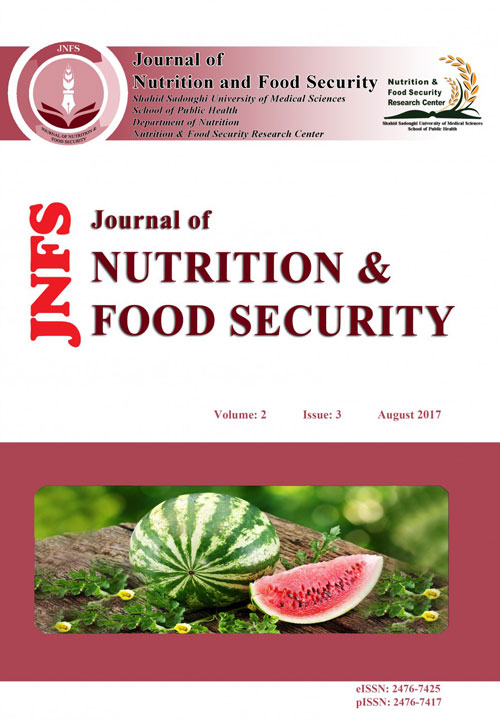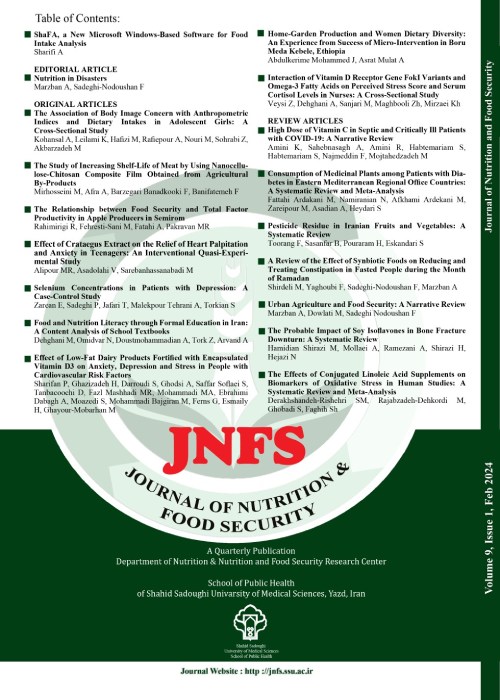فهرست مطالب

Journal of Nutrition and Food Security
Volume:2 Issue: 3, Aug 2017
- تاریخ انتشار: 1396/06/08
- تعداد عناوین: 8
-
Pages 185-193BackgroundEmployees are considered as an at-risk group for obesity and its adverse outcomes, particularly cardiovascular diseases (CVD). The present study was conducted to assess the correlation of obesity indices with CVD risk factors among a group of medical university employees in Zahedan city, southeast of Iran.MethodsThis cross-sectional study recruited 211 healthy employees of Zahedan University of Medical Sciences during October 2015. Obesity indices including body mass index (BMI), waist circumference (WC), waist to hip ratio (WHpR), and waist to height ratio (WHtR) were measured in accordance to the standard criteria. Fasting blood glucose (FBG), blood lipids, and blood pressure were also measured.ResultsWomen had significantly higher values of weight, WC, WHpR, and FBG than men (PConclusionsBMI and WC had an almost moderate correlation with CVD risk factors among the participants. Therefore, using WC along with BMI is suggested as the preferred method for assessment of CVD risk factors.Keywords: Obesity, Waist circumference, Blood glucose, Lipoproteins, Blood pressure
-
Pages 195-200BackgroundIodine is an essential element for growth and development and its inadequate intake leads to insufficient production of thyroid hormone. In developed countries iodine deficiency (ID) is one of the reformable factors. So, this study determined urinary iodine (UI) status of 8-10-year old school children in Yazd province during 2007 to 2016.MethodsThis cross-sectional and descriptive study was conducted on 2236 students who were randomly selected from urban and rural regions with equal proportion of gender. Questionnaires were administered to gather the required descriptive data and then morning samples of urine were collected. Iodine concentration was determined with titration and acidic digestion. Data were analyzed through SPSS software.ResultsDuring the study period, the percentage of students with UI of lower than 2 µg/dL, was zero and only 2.37 % of them had a UI level in the range of 2-4.90 µg/dL. Median of UI was 18.40 ± 7.70 µg/dL level of UI in normal range showed noticeable increase from 2013 to 2016. Level of normal UI in ten years was 79.02%.ConclusionsAccording to the results of this study, Yazd province was considered "IDD free" similar to some other provinces. Also, level of UI more than 30 µg/dL was decreased. It is clear that this approaches need continuous evaluation such as annual evaluation of UI in 8-10 years old students at province level and every five years evaluation at national level.Keywords: Students, Urinary iodine, Iodine deficiency disorder (IDD), Yazd
-
Pages 201-212BackgroundMetabolic syndrome (MetS) is a complex disorder considered as a worldwide epidemic. The aim of this study was to characterize the dietary patterns of Iranian adults and examine its association with metabolic syndrome.MethodsIn this cross-sectional study, 973 persons were selected using multi-stage cluster, random sampling method in Khorramabad city. Dietary intake was assessed using a validated, 168 food-item, self-administrated, and semi-quantitative food-frequency questionnaire (FFQ). To identify the dietary patterns, factor analysis was used for principal components.ResultsThree major dietary patterns were identified: the western dietary pattern (WDP), the healthy dietary pattern (HDP), and the traditional dietary pattern (TDP). Participants in the highest quintile of HDP had lower odds of MetS (OR: 0.45; 95% CI: 0.27-0.77) than those in the lowest quintile, whereas those in the highest quintile of the WDP score had greater odds of the MetS (OR: 3.44; 95% CI: 2.08-5.70) than participants of the lowest quintile. Multi linear regression showed that the WDP score was associated negatively with serum high density lipoprotein-cholesterol and positively with other components of MetS. Even after body mass index adjustment, the association remained significant, except for fasting plasma insulin.Conclusionsa HDP is associated with reduced risk of MetS. In contrast, a WDP is associated with a greater risk of the MetS.Keywords: Metabolic syndrome, Obesity, Dietary pattern, Body mass index
-
Pages 213-220BackgroundThe metabolic syndrome (MetS) is increasing with an alarming rate world wide. Since diet component's studies that focus on MetS have produced largely inconsistent results, assessing the whole diet than single nutrients on health can be more practical. The purpose of this study was to determine the association between diet quality and MetS components.MethodsThis cross-sectional study included a total of 152 participants aged 20-55 years recruited from the endocrinology center of Tehran University of medical sciences. Dietary intake assessed by food frequency questionnaire (FFQ) was used to calculate healthy eating index 2010 (HEI-2010). Body mass index (BMI), weight, height, waist circumference, high density lipoprotein-cholesterol (HDL-c), triglycerides (TG), fasting blood glucose (FBG), and blood pressure were measured.ResultsIn this study HEI mean score was 55.26. Based on HEI-2010 values, diet quality was good in 0.7% of participants, needed improvement in 55.9%, and was poor in 43.4% of cases. Diet quality (HEI) was significantly and linearly related with systolic and diastolic blood pressure, TG, and BMI (PConclusionsAccording to this study, low diet quality can be related to MetS components.Keywords: Metabolic syndrome, Diet quality, Obesity, FBG, Lipid profile
-
Pages 221-230BackgroundThe presence of gluten proteins in rice flour leads to some problems for patients of celiac; a digestive autoimmune disease. Consumption of a non-gluten regime can decrease the effects of this disease. The aim of this study was to produce a non-gluten cake with an appropriate quality and high nutritional value by using rice flour, quinoa flour, Persian gums, and Tragacanth.MethodsThe effect of addition of Persian gums, Tragacanth, and a combination of both of these compounds at levels of 0.5, 1, and 1.5% on texture, color, and sensory characteristics of these cakes was evaluated in this study.ResultsThe results showed that solidity and viscosity factors were elevated by addition of gum to cake. Using of gums in cakes leads to moisture maintenance inside the cake texture and thus improves mastication property. Furthermore, the results of porosity evaluation showed that addition of Persian gums and Tragacanth decreases the size and increases the number of gas cells inside the cake texture and improves porosity. The best porosity was related to the sample containing 1.5% Persian gum and Tragacanth. The treatment that contained 0.75% Persian gum and 0.75% Tragacanth had the highest acceptability among consumers.ConclusionsResults showed that Persian and Tragacanth gums, whether used independently or in combination, can improve the quality and organoleptic characteristics of gluten-free cakes.Keywords: Non-gluten cake, Sensory characteristics, Persian gum, Gum Tragacanth
-
Pages 231-234BackgroundIn recent decades, much interest has been focused on investigating new roles of vitamin D in human body beyond the mineral-ion homeostasis.MethodsBy searching medical databases such as PubMed, over 16000 articles were found which have been published since 2000 on novel aspects of vitamin D in health and diseases.ResultsOf great interest was the effects of vitamin D on decreasing the risk of several chronic illnesses, including common cancers, autoimmune, infectious, and cardiovascular diseases. In this review, the new roles of vitamin D that have recently been investigated were addressed.ConclusionsDue to the vast prevalence of vitamin D deficiency worldwide, it seems that time has come to conduct well-designed clinical trials and meta-analysis to explore the effectiveness of vitamin D supplementation in treatment of common diseases. Finally, the progression in cellular and molecular methods and technology will shed new lights on vitamin D roles in health and disease.Keywords: Vitamin D, Antioxidant, Inflammation, Gastrointestinal diseases, Depression
-
Pages 235-242BackgroundProteins are known mainly based on their metabolic and nutritional functions including protein synthesis and a source of energy. In spite of various physiological properties attributed to proteins, their functions have neither been addressed by assessing quality of proteins nor by nutrition and dietetic practices.MethodsStudies were included if they were randomized animal studies, clinical trials and systematic reviews/meta-analysis published in English language.ResultsThe effect of maternal diet in general and dietary proteins in particular during development on health of offspring has been well-studied. Protein content as well as source of protein in the diet consumed during pregnancy and lactation influenced the risk of metabolic syndrome characteristics in offspring. Both high and low protein diets showed detrimental effects on health of offspring. Moreover, comparison of maternal casein-based diet with soy protein-based diet showed more favorable effect on body weight, body composition, blood pressure, and glucose metabolism in offspring. However, the role of maternal dietary proteins in developing the risk of metabolic syndrome characteristics in offspring in gestational obesity is still unclear and needs further study.ConclusionsDietary proteins are determining factors in developmental programming. Both quantity and source of proteins in maternal diet influenced the development of metabolic syndrome characteristics in offspring. However, whether they have the same function in presence of gestational obesity is still unclear and needs further study.Keywords: Dietary proteins, Developmental programming, Maternal obesity, Metabolic syndrome
-
Pages 243-258BackgroundOral health is a crucial factor for overall well-being and there is a mutual relationship between nutrition and oral health. The aim of this study was to review the publications which have examined the association between nutrition or diet and oral health status or oral disease in Iran.MethodsThe electronic databases of PubMed, Scopus, Google scholar, scientific information database (SID), and Magiran were searched using key words of diet, nutrition, oral health, oral disease, and Iran to reach the related articles published up to 2016. The English and Persian articles with cross-sectional, clinical trial, prospective, and case-control designs were selected. The Persian studies were then translated into English. The animal studies were not investigated.ResultsThe findings showed that nutrition and diet were associated with oral health. However, the majority of studies focused on evaluation of the relation between nutrition and dental caries. Further, a few studies were conducted on the association between nutrition and other oral problems such as periodontal disease or oral cancer. Moreover, the limited nutritional or dietary factors were investigated in the literature.ConclusionsNutrition and diet are related to oral health and prevention of oral disease. Further studies are therefore recommended to evaluate the association between nutrition and oral health with considering various dietary or nutritional factors and different types of oral problems in Iran.Keywords: Nutrition, Diet, Oral health, Oral diseases, Iran


